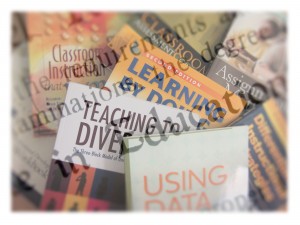 I write “The Principal in Practice” to share what experience has taught. This is one topic you will not find in a textbook or typically offered as a professional development opportunity: how to provide effective administrative management in ending the school year.
I write “The Principal in Practice” to share what experience has taught. This is one topic you will not find in a textbook or typically offered as a professional development opportunity: how to provide effective administrative management in ending the school year.
It is difficult, if not impossible, to create the definitive list of nut and bolt items that need to be addressed as June comes to a close, let alone how to clearly communicate the associated details to the people that need to be informed. That list would not make for particularly engaging reading, and perhaps that is why the topic receives little attention. Yet, overseeing the conclusion of the school year involves critical routine administrative tasks and as Principal, they are your responsibility. What procedures do you have in place to address functions like those listed below, and how do you ensure they are carried out?
Let’s get this cleaned up.
Pick a day and provide a flexible window in which to have teachers take their classes to carry out a locker and classroom cleanup. Co-ordinate this thoughtfully. Do not even consider having every student in the school go out at the same time and start cleaning his or her locker. That is a recipe for pandemonium. Consult with your school custodians when planning activities related to cleanup and the collection and storage of learning resources. They will thank you for it.
Streamlining school property management.
Every school likely has some kind of a system to collecting school property and comparing the inventory to that which was distributed earlier in the school year. If you don’t have a system, you are probably spending money to replace lost and damaged resources when those funds should be spent on something related to student learning. We have a system where lost or damaged items are accounted for and the details are sent to a staff member responsible for creating invoices that are in turn sent to parents. My experience is that an invoice for $200 worth of textbooks frequently results in the prompt return of said textbooks and significant relief for the school’s Learning Resources budget.
Dates, deadlines and who is responsible for what.
There are literally hundreds of tasks that need to be completed in winding down the school year. It is not possible to list every one of them, but a general calendar of activities keeps things on track.
Let’s examine one activity that all schools are required to do: reporting marks to the Department of Education at the end of the school year. To do this, office admin staff has to import and process data. That data is generated by teachers who carry out assessments. Those assessment need to be completed by a certain time in order to allow all of this to happen. I am in the habit of identifying specific dates and times for things to happen. It is not unreasonable to require that all teachers have entered all marks and comments into the reporting system by a certain time on a certain day. That timeline needs to be clearly articulated.
A word of advice: give yourself enough time to deal with the inevitable glitches. If your data is housed on a remote server that is also hosting data from numerous other school divisions, know that the server may be operating slowly at the end of June as it processes all that data. Also, remember that when things go wrong you will be on a waiting list for tech support. Factor such delays into your planning.
Let’s be perfectly clear on assessment.
Ideally, you are having ongoing conversations about student assessment and this topic accounts for at least a part of your school based professional development activities. However every school division has a policy around student assessment and you should draw teachers’ attention to it not only at the start of the year but just prior to each reporting period as well. There are so many procedures that teachers need to remember; a quick review of the expectations around student assessment prior to the generation of reports provides clarification and ensures implementation of proper procedure.
How to plan surprise-free graduation and awards ceremonies.
Whether you are planning a high school graduation ceremony or a school based awards night, someone is ultimately responsible for ensuring things happen as they should. As principal, you need to clearly articulate the tasks for which you are taking active responsibility and those which you are delegating to others. However, make sure you have some sort of accountability process in place for those tasks you delegate – some mechanism to assure yourself that the critical functions associated with planning these types of events are fulfilled. Be aware that delegated tasks that are not attended to in a timely fashion will come back to you for action. Assign tasks, attach detailed timelines, and follow up to provide support and address challenges as they arise.
Details, details, details: School Supplies and Fees lists.
Who has responsibility for updating and generating these lists? Does your school supplies list include obsolete items? Parents won’t know this and will purchase what you have placed on the list. Don’t waste their time and money by distributing a dated list.
Do parents know students may need things like headphones or data storage devices? Do they have any idea what cloud storage is and how to access it? I recommend your school supplies list is hotlinked to samples so that people have a clear idea as to what they should be purchasing. The school supplies list is also a place to include your school division’s policy on “Bring Your Own Device” so that people who are purchasing technology for student use are making informed decisions.
Does your school division have a policy on school fees? Are there user fees for consumable items in courses like Home Economics or Industrial Arts? Is the fee schedule current? These things can change from year to year, so consult with your staff so that parents receive accurate information.
This is not a meeting item!
I am a firm believer that anything that can be dealt with in a memo should be dealt with in that fashion. Do not waste valuable staff meeting time talking about any of the above, unless it is a matter that requires a discussion or a decision.
My practice has been to distribute a lengthy memo about 8 weeks prior to the end of the school year that deals with all the “administrivia” that is a necessary part of effective school management. Prefaced by a modest apology about the length that follows, it contains specific details related to year end procedures. Not only does it include critical dates and deadlines, but it clearly states who is responsible for what, to whom reports and documents are to be submitted, and where to find the resources to carry out assigned tasks. During those 8 weeks, I make notations about what worked and what did not, and use that as the basis for revisions that are implemented in subsequent years.
Deliberate attention = good practice.
Efficient practice is critical in saving time and bringing clarity to the complex task of successfully concluding the school year. As Principal, one ideally wants to spend one’s time on matters related to instructional leadership. However, there is more than one dimension to the principalship. Efficient practice will provide you with the time to focus on your priorities.
Ironically, it is the absence of sound planning that draws attention. Deliberate attention on effective school management where roles and responsibilities are clearly articulated contributes to a positive atmosphere and a successful end to the school year.
 I have participated in numerous school based Remembrance Day ceremonies. From my observations over the years, I have concluded that the participation of the student population in a traditional assembly style Remembrance Day ceremony typically falls into one of three categories:
I have participated in numerous school based Remembrance Day ceremonies. From my observations over the years, I have concluded that the participation of the student population in a traditional assembly style Remembrance Day ceremony typically falls into one of three categories: For example, one period may see all teachers have their students view a particular video from the Veterans Affairs Video Gallery. Staff is provided with a simple discussion guide to use in engaging the students in dialogue about what they viewed. The next period may start with students reading Remembrance Day reflections over the school PA system, or perhaps explore classroom based reading selections. The Veterans Affairs “Ways to Remember” page provides a wealth of school and classroom based approaches to foster active participation in Remembrance Day.
For example, one period may see all teachers have their students view a particular video from the Veterans Affairs Video Gallery. Staff is provided with a simple discussion guide to use in engaging the students in dialogue about what they viewed. The next period may start with students reading Remembrance Day reflections over the school PA system, or perhaps explore classroom based reading selections. The Veterans Affairs “Ways to Remember” page provides a wealth of school and classroom based approaches to foster active participation in Remembrance Day.







